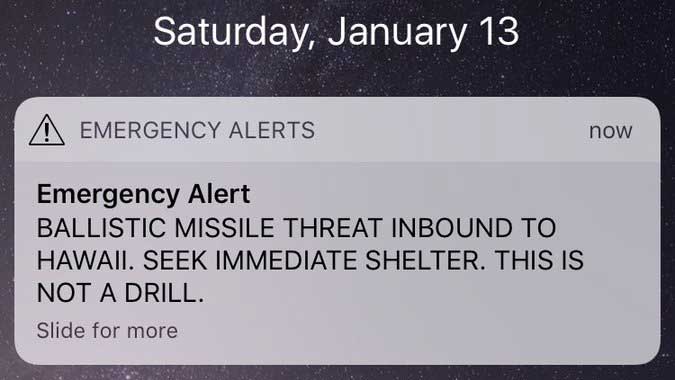FCC Investigating Missile False Alarm

A bogus emergency alert text message warning Hawaii residents of an incoming ballistic missile is under investigation by the FCC, spokesman Brian Hart said Saturday (Jan. 13).
Hawaii residents received a text warning that said it was not a drill. FCC Chairman Ajit Pai tweeted: "The @FCC is launching a full investigation into the false emergency alert that was sent to residents of Hawaii." He said it appeared that Hawaii did not have "reasonable safeguards" or processes to prevent such an error.
Pai also retweeted the following:
U.S. Pacific Command has detected no ballistic missile threat to #Hawaii. Earlier message was sent in error and was a false alarm. pic.twitter.com/Lvg17VNjiF
— U.S. Pacific Command (@PacificCommand) January 13, 2018
There were online reports of children being placed in storm drains for shelter and residents ducking, covering and crying. With the tensions between the U.S. and North Korea over the latter's nuclear program, the false alarm clearly had the ring of truth with some folks. KHON-TV Honolulu reported that state emergency officials sent out the mistaken text (pictured above from a text by Hawaii Rep. Tulsi Gabbard).
Sen Brian Schatz (D-Hawaii), the ranking member on the Senate Communications Subcommittee, was not happy.
“There is no excuse for yesterday’s false alarm and the failure to quickly correct it," he said in a statement. "It terrified residents and visitors, and it undermined our ability to notify the public in a real emergency.
“This incident exposed serious weaknesses in our state’s emergency alert system that must be fixed. That’s why I’m working closely with the FCC, including Chairman Ajit Pai and Commissioner Jessica Rosenworcel, to investigate the incident, identify vulnerabilities in our system, and develop solutions and best practices for the federal government, states, and municipalities to make sure this never happens again. This system failed miserably. We need to improve it, and get it right.”
Pai weighed in again Sunday (Jan. 14) making the same point and several more.
“The false emergency alert sent yesterday in Hawaii was absolutely unacceptable," he said. "It caused a wave of panic across the state—worsened by the 38-minute delay before a correction alert was issued. Moreover, false alerts undermine public confidence in the alerting system and thus reduce their effectiveness during real emergencies.
“The FCC’s investigation into this incident is well underway. We have been in close contact with federal and state officials, gathering the facts about how this false alert was issued. Based on the information we have collected so far, it appears that the government of Hawaii did not have reasonable safeguards or process controls in place to prevent the transmission of a false alert.
“Moving forward, we will focus on what steps need to be taken to prevent a similar incident from happening again. Federal, state, and local officials throughout the country need to work together to identify any vulnerabilities to false alerts and do what’s necessary to fix them. We also must ensure that corrections are issued immediately in the event that a false alert does go out.”
Broadcasting & Cable Newsletter
The smarter way to stay on top of broadcasting and cable industry. Sign up below
Contributing editor John Eggerton has been an editor and/or writer on media regulation, legislation and policy for over four decades, including covering the FCC, FTC, Congress, the major media trade associations, and the federal courts. In addition to Multichannel News and Broadcasting + Cable, his work has appeared in Radio World, TV Technology, TV Fax, This Week in Consumer Electronics, Variety and the Encyclopedia Britannica.

